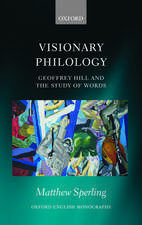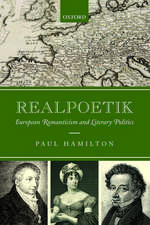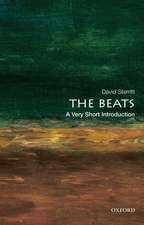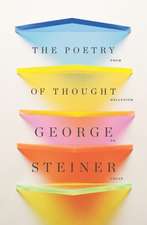Baudelaire's Media Aesthetics: The Gaze of the Flâneur and 19th-Century Media
Autor Dr. Marit Grøttaen Limba Engleză Paperback – 19 oct 2016
| Toate formatele și edițiile | Preț | Express |
|---|---|---|
| Paperback (1) | 256.12 lei 6-8 săpt. | |
| Bloomsbury Publishing – 19 oct 2016 | 256.12 lei 6-8 săpt. | |
| Hardback (1) | 713.72 lei 6-8 săpt. | |
| Bloomsbury Publishing – 17 iun 2015 | 713.72 lei 6-8 săpt. |
Preț: 256.12 lei
Preț vechi: 330.47 lei
-22% Nou
Puncte Express: 384
Preț estimativ în valută:
49.01€ • 51.40$ • 40.80£
49.01€ • 51.40$ • 40.80£
Carte tipărită la comandă
Livrare economică 01-15 aprilie
Preluare comenzi: 021 569.72.76
Specificații
ISBN-13: 9781501326448
ISBN-10: 1501326449
Pagini: 216
Ilustrații: 10 bw illus
Dimensiuni: 152 x 229 x 12 mm
Greutate: 0.3 kg
Ediția:NIPPOD
Editura: Bloomsbury Publishing
Colecția Bloomsbury Academic
Locul publicării:New York, United States
ISBN-10: 1501326449
Pagini: 216
Ilustrații: 10 bw illus
Dimensiuni: 152 x 229 x 12 mm
Greutate: 0.3 kg
Ediția:NIPPOD
Editura: Bloomsbury Publishing
Colecția Bloomsbury Academic
Locul publicării:New York, United States
Caracteristici
Opens up a new perspective on Baudelaire's writings and throws new light on the figure of the flâneur
Notă biografică
Marit Grøtta is Associate Professor of Comparative Literature at the University of Oslo, Norway.
Cuprins
1. Introduction2. Newspapers3. Photographs4. Pre-cinematic Devices5. Corporeality6. Toys7. Media Imagery and Modernity BibliographyIndex
Recenzii
Grøtta is as comfortable dissecting four lines of a Baudelaire prose poem as she is discerning broad shifts in critical approaches to media. . The book offers unfailingly interesting micro-histories of the various dispositives under scrutiny, and the debate that emerges is always inclusive and informed. . [T]he contention that Baudelaire's writings often paraphrased the conventions of new media is defended with an agility and intellectual vigor that prove, in the end, difficult to resist.
Although Baudelaire in 1859 famously denounced photography as sterile technology aiming to reproduce reality at the expense of artistic beauty, his writing was in fact framed, fashioned, and mediated through the new visual media of the period. In this rich multidisciplinary study, Grøtta argues that Baudelaire's poetic sensibility can be fully understood only in the context of the media-saturated environment in which it took shape . Drawing on careful analysis of Baudelaire's prose poems and theories of writers as different as Marx, Freud, Benjamin, and Agamben, Grøtta skillfully brings to light Baudelaire's complex relationship with the rapidly developing text and image-based media of the 19th century . Summing Up: Recommended. Lower-division undergraduates and above; general readers.
Grøtta offers a thorough examination of the poet's art as the aesthetics of Paris's flâneur par excellence. ... A time museum of sorts, this book can be conceived as a stroll through galleries devoted to the new media available in Baudelaire's society. The role of newspapers, photographs, precinematic devices, toys, and corporeality in Baudelaire's works is substantiated by remarkable analyses of his Petits Poèmes en Prose. Grøtta skilfully masters the delicate art of lively description. .... All in all, Marit Grøtta's monograph is a delightful and perfectly documented work that certainly deserves to be read by comparative literature scholars. As an original effort to bridge the gap between too often separated though arguably related disciplines, this book definitely offers new avenues through which to explore the link between literary analysis and visual (or other) mediation. ... [Readers] will surely appreciate the opportunity of going back in time offered by Grotta's remarkable scholarly work.
[Grøtta] has provided the context-prior and contemporary-to Baudelaire's writings in a large number of areas: fascinating glimpses of public amusements, optical toys, slang expressions, as well as explanations, market considerations, and interpretations. This wealth of information makes her arguments-clearly restated at chapter's end-easy to accept. ... What Grøtta does is essential to a deeper understanding of Baudelaire: despite Baudelaire's aversion to photography, she detects in it a cult of the image and a concept of identity that would only become widespread with the advent of the twentieth century and its use of identity cards. ... Grøtta traces Baudelaire's debts, and these debts are not to the usual authors and creditors, but to fields, devices, and practices that the poet explicitly disdained: the press, and its use of commonplaces; photography, and its appeal to the masses and their uncritical acceptance of its 'truth'; toys, and their vulgarity.
This assured study looks at the wide aesthetic implications of Baudelaire's engagement with new and emerging media technologies. With chapters on newspapers, photographs, and pre-cinematic devices such as the kaleidoscope, Marit Grøtta's book challenges narrow Benjaminian-inflected readings of Baudelaire by offering fresh analyses of familiar prose poems that showcase Baudelaire's awareness of new ways of experiencing the world . This book is suitable for readers both familiar with and new to Baudelaire. Grøtta's strength lies in the limpidity of her writing, which clearly condenses Baudelaire's aesthetic thought in relation to different media forms.
Grøtta clearly knows Baudelaire's personal and literary writings very well and skilfully reads the interactions between media and literature ... Baudelaire's Media Aesthetics will be of particular value for anyone who is interested in Baudelaire as a writer and also, perhaps not that surprisingly, for those interested in Walter Benjamin.
Grøtta's Baudelaire's Media Aesthetics is a highly topical, trans-disciplinary exploration of Baudelaire's writings in the wider context of the evolution of text- and image-based media, from newspapers to photography and pre-cinematic technologies, in nineteenth-century France. Innovatively bringing together literary and visual culture studies, and drawing on theorists such as Walter Benjamin and Giorgio Agamben, Grøtta's discussion sheds new light not only on Baudelaire's writings, but also on the figure of the flâneur, mediated viewing and mobile perception, among other topics in media and cultural studies.
By reading Baudelaire's relation to various 19th century media, including newspapers, painting, photography, and optical toys such as kaleidoscopes, Baudelaire's Media Aesthetics offers a compelling alternative to Walter Benjamin's influential account of his poetry and aesthetics and advances our understanding of the emergence of a new media world out of its 19th century beginnings.
Marit Grøtta's book brings a renewed view to the prose poetry of Baudelaire by exploring his immersion in the new print and visual media environment of his time. Balancing a literary approach to prose poetry with a conceptualization of media as living environment and technical forms of mediation, Baudelaire's Media Aesthetics sheds new light on the modern "optical unconscious"and develops an original interpretive frame to read Walter Benjamin via Baudelaire, rather than the other way around. With astute links between the works of Marx, Freud, and Benjamin, Grøtta offers a fresh portrait of the flâneur, which she also enriches with her analyses of the divergent views on modern media by Giorgio Agamben and Bruno Latour.
Baudelaire's Media Aesthetics invites us to look back at Charles Baudelaire's writings through the specificity and historicity of new technologies of vision rather than with the naked eye alone. . The book analyses a thought-provoking combination of media.to study similarities between Baudelaire's encounters with different media and assess how media played a role in shaping his idea of modernity. . The entire book is clearly argued and logically presented. . Grøtta's book therefore makes a significant contribution to our understanding of Baudelaire, "a lyric poet in the age of new media" (6) as read by Benjamin, but also of Benjamin's writings on visual technologies as they relate to Baudelaire by way of Agamben's readings of both Baudelaire and Benjamin. The book's appeal is indeed that it can make such complex connections among poems and media in an engaging, coherent, and lucid analysis.
Although Baudelaire in 1859 famously denounced photography as sterile technology aiming to reproduce reality at the expense of artistic beauty, his writing was in fact framed, fashioned, and mediated through the new visual media of the period. In this rich multidisciplinary study, Grøtta argues that Baudelaire's poetic sensibility can be fully understood only in the context of the media-saturated environment in which it took shape . Drawing on careful analysis of Baudelaire's prose poems and theories of writers as different as Marx, Freud, Benjamin, and Agamben, Grøtta skillfully brings to light Baudelaire's complex relationship with the rapidly developing text and image-based media of the 19th century . Summing Up: Recommended. Lower-division undergraduates and above; general readers.
Grøtta offers a thorough examination of the poet's art as the aesthetics of Paris's flâneur par excellence. ... A time museum of sorts, this book can be conceived as a stroll through galleries devoted to the new media available in Baudelaire's society. The role of newspapers, photographs, precinematic devices, toys, and corporeality in Baudelaire's works is substantiated by remarkable analyses of his Petits Poèmes en Prose. Grøtta skilfully masters the delicate art of lively description. .... All in all, Marit Grøtta's monograph is a delightful and perfectly documented work that certainly deserves to be read by comparative literature scholars. As an original effort to bridge the gap between too often separated though arguably related disciplines, this book definitely offers new avenues through which to explore the link between literary analysis and visual (or other) mediation. ... [Readers] will surely appreciate the opportunity of going back in time offered by Grotta's remarkable scholarly work.
[Grøtta] has provided the context-prior and contemporary-to Baudelaire's writings in a large number of areas: fascinating glimpses of public amusements, optical toys, slang expressions, as well as explanations, market considerations, and interpretations. This wealth of information makes her arguments-clearly restated at chapter's end-easy to accept. ... What Grøtta does is essential to a deeper understanding of Baudelaire: despite Baudelaire's aversion to photography, she detects in it a cult of the image and a concept of identity that would only become widespread with the advent of the twentieth century and its use of identity cards. ... Grøtta traces Baudelaire's debts, and these debts are not to the usual authors and creditors, but to fields, devices, and practices that the poet explicitly disdained: the press, and its use of commonplaces; photography, and its appeal to the masses and their uncritical acceptance of its 'truth'; toys, and their vulgarity.
This assured study looks at the wide aesthetic implications of Baudelaire's engagement with new and emerging media technologies. With chapters on newspapers, photographs, and pre-cinematic devices such as the kaleidoscope, Marit Grøtta's book challenges narrow Benjaminian-inflected readings of Baudelaire by offering fresh analyses of familiar prose poems that showcase Baudelaire's awareness of new ways of experiencing the world . This book is suitable for readers both familiar with and new to Baudelaire. Grøtta's strength lies in the limpidity of her writing, which clearly condenses Baudelaire's aesthetic thought in relation to different media forms.
Grøtta clearly knows Baudelaire's personal and literary writings very well and skilfully reads the interactions between media and literature ... Baudelaire's Media Aesthetics will be of particular value for anyone who is interested in Baudelaire as a writer and also, perhaps not that surprisingly, for those interested in Walter Benjamin.
Grøtta's Baudelaire's Media Aesthetics is a highly topical, trans-disciplinary exploration of Baudelaire's writings in the wider context of the evolution of text- and image-based media, from newspapers to photography and pre-cinematic technologies, in nineteenth-century France. Innovatively bringing together literary and visual culture studies, and drawing on theorists such as Walter Benjamin and Giorgio Agamben, Grøtta's discussion sheds new light not only on Baudelaire's writings, but also on the figure of the flâneur, mediated viewing and mobile perception, among other topics in media and cultural studies.
By reading Baudelaire's relation to various 19th century media, including newspapers, painting, photography, and optical toys such as kaleidoscopes, Baudelaire's Media Aesthetics offers a compelling alternative to Walter Benjamin's influential account of his poetry and aesthetics and advances our understanding of the emergence of a new media world out of its 19th century beginnings.
Marit Grøtta's book brings a renewed view to the prose poetry of Baudelaire by exploring his immersion in the new print and visual media environment of his time. Balancing a literary approach to prose poetry with a conceptualization of media as living environment and technical forms of mediation, Baudelaire's Media Aesthetics sheds new light on the modern "optical unconscious"and develops an original interpretive frame to read Walter Benjamin via Baudelaire, rather than the other way around. With astute links between the works of Marx, Freud, and Benjamin, Grøtta offers a fresh portrait of the flâneur, which she also enriches with her analyses of the divergent views on modern media by Giorgio Agamben and Bruno Latour.
Baudelaire's Media Aesthetics invites us to look back at Charles Baudelaire's writings through the specificity and historicity of new technologies of vision rather than with the naked eye alone. . The book analyses a thought-provoking combination of media.to study similarities between Baudelaire's encounters with different media and assess how media played a role in shaping his idea of modernity. . The entire book is clearly argued and logically presented. . Grøtta's book therefore makes a significant contribution to our understanding of Baudelaire, "a lyric poet in the age of new media" (6) as read by Benjamin, but also of Benjamin's writings on visual technologies as they relate to Baudelaire by way of Agamben's readings of both Baudelaire and Benjamin. The book's appeal is indeed that it can make such complex connections among poems and media in an engaging, coherent, and lucid analysis.













